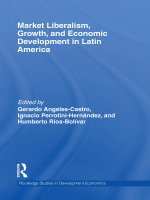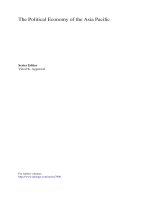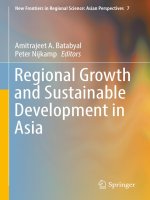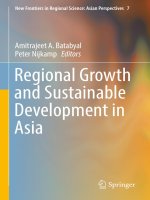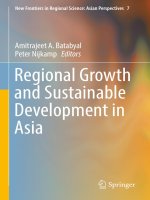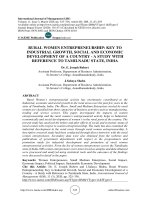Economic growth and economic development 180
Bạn đang xem bản rút gọn của tài liệu. Xem và tải ngay bản đầy đủ của tài liệu tại đây (65.43 KB, 1 trang )
Introduction to Modern Economic Growth
the presence of Pareto-ranked equilibria. This implies that one equilibrium gives
higher utility or welfare to all agents than another. While such Pareto-ranked equilibria are a feature of our parsimonious models, which do not specify many relevant
dimensions of heterogeneity that are important in practice, it is not clear whether
they are useful in thinking about why some countries are rich and some are poor. If
indeed it were possible for Nigerians to change their behavior and for all individuals
in the nation to become better off (say by switching from low to high investment
in terms of the game above), it is very difficult to believe that for 200 years they
have not been able to coordinate on such a better action. Most readers will be
aware that Nigerian history is shaped by religious and ethnic conflict, by the civil
war that ravaged the nation, and is still adversely affected by the extreme corruption of politicians, bureaucrats and soldiers that have enriched themselves at the
expense of the population at large. That an easy Pareto improving change against
this historical and social background seems improbable to say the least.
To be fair, not all models of “multiple equilibria” allow easy transitions from
a Pareto inferior equilibrium to a superior equilibrium. In the literature, a useful
distinction is between models of multiple equilibria, where different equilibria can
be reached if individuals change their beliefs and behaviors simultaneously, versus
models of multiple steady states with history dependence, where once a particular
path of equilibrium is embarked upon, it becomes much harder (perhaps impossible) to transition to the other steady state equilibrium (see Chapter 22). Such models are much more attractive for understanding persistent differences in economic
performance across countries. Nevertheless, unless some other significant source of
conflict of interest or distortions are incorporated, it seems unlikely that the difference between the United States and Nigeria can be explained by using models
where the two countries have identical parameters, but have made different choices
and stuck with them. The mechanics of how a particular steady-state equilibrium
can be maintained would be the most important element of such a theory, and other
fundamental causes of economic growth, including institutions, policies or perhaps
culture, must play a role in explaining this type of persistence. Put differently, in
today’s world of free information, technology and capital flows, if Nigeria had the
same parameters, the same opportunities and the same “institutions” as the United
166
